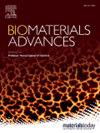Tailoring metabolic activity assays for tumour-engineered 3D models
IF 5.5
2区 医学
Q2 MATERIALS SCIENCE, BIOMATERIALS
Materials Science & Engineering C-Materials for Biological Applications
Pub Date : 2024-11-12
DOI:10.1016/j.bioadv.2024.214116
引用次数: 0
Abstract
Monitoring cell behaviour in hydrogel-based 3D models is critical for assessing their growth and response to cytotoxic treatment. Resazurin-based PrestoBlue and AlamarBlue reagents are frequently used metabolic activity assays when determining cell responses. However, both assays are largely applied to cell monolayer cultures but yet to have a defined protocol for use in hydrogel-based 3D models. The assays' performance depends on the cell type, culture condition and measurement sensitivity. To better understand how both assays perform, we grew pancreatic cancer cells in gelatin methacryloyl and collagen hydrogels and evaluated their metabolic activity using different concentrations and incubation times of the PrestoBlue and AlamarBlue reagents. We tested reagent concentrations of 4 % and 10 % and incubation times of 45 min, 2 h and 4 h. In addition, we co-cultured cancer cells together with cancer-associated fibroblasts and peripheral blood mononuclear cells in gelatin methacryloyl hydrogels and subjected them to gemcitabine and nab-paclitaxel to evaluate how both assays perform when characterising cell responses upon drug treatment. CyQuant assays were conducted on the same samples and compared to data from the metabolic activity assays. In cancer monocultures, higher reagent concentration and incubation time increased fluorescent intensity. We found a reagent concentration of 10 % and an incubation time of 2 h suitable for all cell lines and both hydrogels. In multicellular 3D cultures, PrestoBlue and AlamarBlue assays detected similar cell responses upon drug treatment but overestimated cell growth. We recommend to assess cell viability and growth in conjunction with CyQuant assays that directly measure cell functions.
为肿瘤工程三维模型量身定制新陈代谢活性检测方法。
监测水凝胶三维模型中的细胞行为对于评估细胞的生长和对细胞毒性治疗的反应至关重要。在确定细胞反应时,基于石蕊青的 PrestoBlue 和 AlamarBlue 试剂是常用的代谢活性检测方法。不过,这两种检测方法主要应用于细胞单层培养,但在基于水凝胶的三维模型中使用时还没有明确的方案。这两种检测方法的性能取决于细胞类型、培养条件和测量灵敏度。为了更好地了解这两种检测方法的性能,我们在明胶甲基丙烯酰和胶原水凝胶中培养了胰腺癌细胞,并使用不同浓度和孵育时间的 PrestoBlue 和 AlamarBlue 试剂评估了它们的代谢活性。此外,我们还在明胶甲基丙烯酰水凝胶中将癌细胞与癌症相关成纤维细胞和外周血单核细胞共同培养,并让它们接受吉西他滨和纳布紫杉醇的治疗,以评估这两种检测方法在描述药物治疗时细胞反应的性能。对相同的样品进行了 CyQuant 检测,并与代谢活性检测的数据进行了比较。在癌症单一培养物中,试剂浓度和培养时间越高,荧光强度越高。我们发现,10% 的试剂浓度和 2 小时的孵育时间适用于所有细胞系和两种水凝胶。在多细胞三维培养中,PrestoBlue 和 AlamarBlue 检测法检测到的细胞对药物处理的反应相似,但高估了细胞的生长。我们建议结合直接测量细胞功能的 CyQuant 检测法来评估细胞活力和生长。
本文章由计算机程序翻译,如有差异,请以英文原文为准。
求助全文
约1分钟内获得全文
求助全文
来源期刊
CiteScore
17.80
自引率
0.00%
发文量
501
审稿时长
27 days
期刊介绍:
Biomaterials Advances, previously known as Materials Science and Engineering: C-Materials for Biological Applications (P-ISSN: 0928-4931, E-ISSN: 1873-0191). Includes topics at the interface of the biomedical sciences and materials engineering. These topics include:
• Bioinspired and biomimetic materials for medical applications
• Materials of biological origin for medical applications
• Materials for "active" medical applications
• Self-assembling and self-healing materials for medical applications
• "Smart" (i.e., stimulus-response) materials for medical applications
• Ceramic, metallic, polymeric, and composite materials for medical applications
• Materials for in vivo sensing
• Materials for in vivo imaging
• Materials for delivery of pharmacologic agents and vaccines
• Novel approaches for characterizing and modeling materials for medical applications
Manuscripts on biological topics without a materials science component, or manuscripts on materials science without biological applications, will not be considered for publication in Materials Science and Engineering C. New submissions are first assessed for language, scope and originality (plagiarism check) and can be desk rejected before review if they need English language improvements, are out of scope or present excessive duplication with published sources.
Biomaterials Advances sits within Elsevier''s biomaterials science portfolio alongside Biomaterials, Materials Today Bio and Biomaterials and Biosystems. As part of the broader Materials Today family, Biomaterials Advances offers authors rigorous peer review, rapid decisions, and high visibility. We look forward to receiving your submissions!

 求助内容:
求助内容: 应助结果提醒方式:
应助结果提醒方式:


